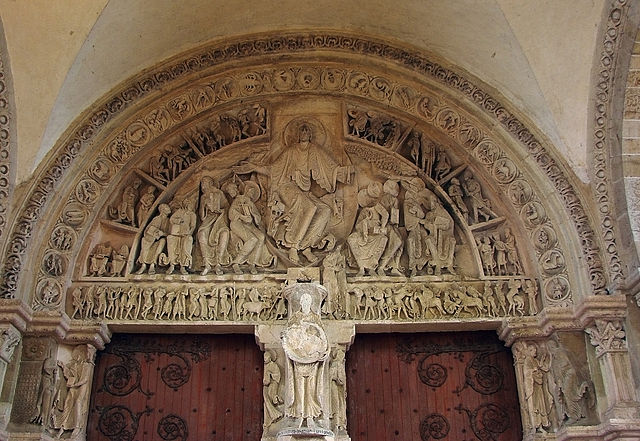A tympanum is the semi-circular or triangular decorative wall surface over an entrance, door or window, which is bounded by a lintel and an arch. It often contains pedimental sculpture or other imagery or ornaments. Many architectural styles include this element.
The late Romanesque tympanum of Vézelay Abbey, Burgundy, France, 1130s
Baroque tympanum in the Queen's Bedroom in the Louvre Palace, Paris, by Michel Anguier and Pietro Sasso, with a painting of Judith and Holophernes, by Giovanni Francesco Romanelli, 1655
Ex Nihilo (Out of Nothing) by Frederick Hart, tympanum over center doors, Washington National Cathedral, US
Tympanum of Kumari-ghar at Basantapur Durbar Square, Kathmandu
Pedimental sculpture is a form of architectural sculpture designed for installation in the tympanum, the space enclosed by the architectural element called the pediment. Originally a feature of Ancient Greek architecture, pedimental sculpture started as a means to decorate a pediment in its simplest form: a low triangle, like a gable, above an horizontal base or entablature. However, as classical architecture developed from the basis of Ancient Greek and Roman architecture, the varieties of pedimental sculpture also developed. The sculpture can be either freestanding or relief sculpture, in which case it is attached to the back wall of the pediment. Harris in The Illustrated Dictionary of Historic Architecture defines pediment as "In classical architecture, the triangular gable end of the roof above the horizontal cornice, often filled with sculpture." Pediments can also be used to crown doors or windows.

Neoclassical pediment of La Madeleine Church, Paris, with sculpture (1826–1834) by Philippe Joseph Henri Lemaire
Reconstruction, including casts, of the East pediment of the Temple of Zeus, Olympia, c. 460 BCE, Pushkin Museum, Moscow
The "earliest pedimental composition to have survived," from the Early Archaic Period, from the Temple of Artemis, Corfu, about 580–570 BCE, now Archaeological Museum of Corfu.
Apollo struggling with Heracles, Siphnian Treasury at Delphi (about 525 BCE)








